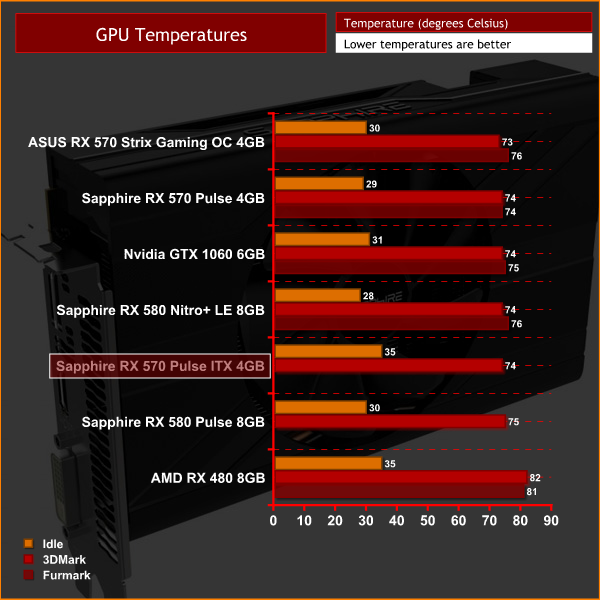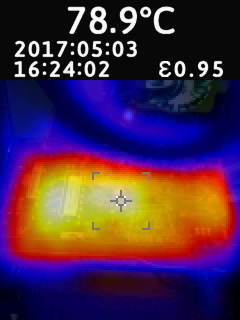Temperatures were measured after 5 minutes of load under three scenario: Furmark, Fire Strike and desktop idle in sequential order with 2 minutes of downtime in between each test. GPU-Z was used to record the maximum temperature, fan profiles on GPUs were left to their default behaviour.
Some cards have no result recorded for the Furmark test, as I found a couple of the cards underclocked themselves to avoid long-term damage, so the temperature levels were much lower.
We present figures as read by GPU-Z (not deltas), and ambient temperature fluctuated between 19-20C during testing.
In terms of thermal performance, the RX 570 Pulse ITX performed very well. It obviously benefits from a lack of factory overclock which helps it stay competitive, but even so, a peak of 74 degrees is impressive for such a small card.
The lack of backplate does not seem to hurt the card too much, either, as I measured a peak temperature on the PCB of 79C. This is well within the boundary for acceptable thermal performance.
 KitGuru KitGuru.net – Tech News | Hardware News | Hardware Reviews | IOS | Mobile | Gaming | Graphics Cards
KitGuru KitGuru.net – Tech News | Hardware News | Hardware Reviews | IOS | Mobile | Gaming | Graphics Cards





What kind software that you use for gpu oc stress testing?
I have the same card and test it through unigine valley, i could pull it to 1400mhz on core and 2000mhz on memory ,
Im not noticing any artifacts, but not quite sure cause i only use 720p 24inch hdtv
wanna stress the shit out of the card and drive the temps to the max?download primecoin wallet and run claymore primecoin miner.Then u will see the real temps and how good the cooler is.
wanna stress the shit out of the card and drive the temps to the max?download primecoin wallet and run claymore primecoin miner.Then u will see the real temps and how good the cooler is.
Using software?
Give it more juice. Increase the power limit so your card won’t throttle.
Why is the RX 570 pulse mini drawing 10 more watts than a regular Rx 570 in idle? If anything it should be the other way round, with the mini using less power in idle. Is it a typing error here?
Just bought two for mining and gaming, they arrive in a couple of days, looking forward seeing what they can do